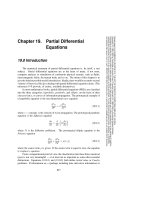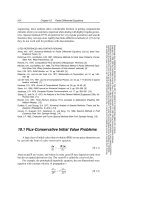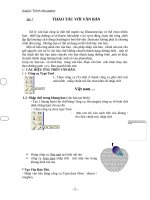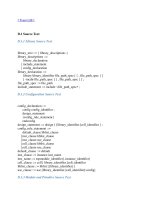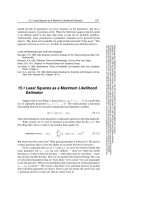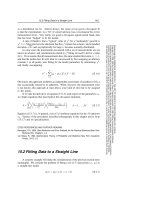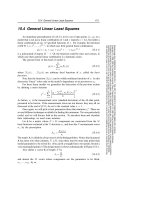Tài liệu Partial Differential Equations part 7 doc
Bạn đang xem bản rút gọn của tài liệu. Xem và tải ngay bản đầy đủ của tài liệu tại đây (284.9 KB, 18 trang )
19.6 Multigrid Methods for Boundary Value Problems
871
Sample page from NUMERICAL RECIPES IN C: THE ART OF SCIENTIFIC COMPUTING (ISBN 0-521-43108-5)
Copyright (C) 1988-1992 by Cambridge University Press.Programs Copyright (C) 1988-1992 by Numerical Recipes Software.
Permission is granted for internet users to make one paper copy for their own personal use. Further reproduction, or any copying of machine-
readable files (including this one) to any servercomputer, is strictly prohibited. To order Numerical Recipes books,diskettes, or CDROMs
visit website or call 1-800-872-7423 (North America only),or send email to (outside North America).
standardtridiagonalalgorithm. Givenu
n
,onesolves(19.5.36)foru
n+1/2
,substitutes
on the right-hand side of (19.5.37), and then solves for u
n+1
. The key question
is how to choose the iteration parameter r, the analog of a choice of timestep for
an initial value problem.
As usual, the goal is to minimize the spectral radius of the iteration matrix.
Although it is beyond our scope to go into details here, it turns out that, for the
optimal choice of r, the ADI method has the same rate of convergence as SOR.
The individual iteration steps in the ADI method are much more complicated than
in SOR, so the ADI method would appear to be inferior. This is in fact true if we
choose the same parameter r for every iteration step. However, it is possible to
choose a different r for each step. If this is done optimally, then ADI is generally
more efficient than SOR. We refer you to the literature
[1-4]
for details.
Our reason for not fully implementing ADI here is that, in most applications,
it has been superseded by the multigrid methods described in the next section. Our
advice is to use SOR for trivial problems (e.g., 20 × 20), or for solving a larger
problem once only, where ease of programming outweighs expense of computer
time. Occasionally, the sparse matrix methods of §2.7 are useful for solving a set
of difference equations directly. For production solution of large elliptic problems,
however, multigrid is now almost always the method of choice.
CITED REFERENCES AND FURTHER READING:
Hockney, R.W., and Eastwood, J.W. 1981,
Computer Simulation Using Particles
(New York:
McGraw-Hill), Chapter 6.
Young, D.M. 1971,
Iterative Solution of Large Linear Systems
(New York: Academic Press). [1]
Stoer, J., and Bulirsch, R. 1980,
Introduction to Numerical Analysis
(New York: Springer-Verlag),
§§
8.3–8.6. [2]
Varga, R.S. 1962,
Matrix Iterative Analysis
(Englewood Cliffs, NJ: Prentice-Hall). [3]
Spanier, J. 1967, in
Mathematical Methods for Digital Computers, Volume 2
(New York: Wiley),
Chapter 11. [4]
19.6 Multigrid Methods for Boundary Value
Problems
Practical multigridmethods were first introduced in the 1970s by Brandt. These
methods can solve elliptic PDEs discretized on N grid points in O(N) operations.
The “rapid” direct elliptic solvers discussed in §19.4 solve special kinds of elliptic
equations in O(N log N) operations. The numerical coefficients in these estimates
are such that multigrid methods are comparable to the rapid methods in execution
speed. Unlike the rapid methods, however, the multigrid methods can solve general
elliptic equations with nonconstant coefficients with hardly any loss in efficiency.
Even nonlinear equations can be solved with comparable speed.
Unfortunately there is not a single multigrid algorithm that solves all elliptic
problems. Rather there is a multigrid technique that provides the framework for
solving these problems. You have to adjust the various components of the algorithm
within this framework to solve your specific problem. We can only give a brief
872
Chapter 19. Partial Differential Equations
Sample page from NUMERICAL RECIPES IN C: THE ART OF SCIENTIFIC COMPUTING (ISBN 0-521-43108-5)
Copyright (C) 1988-1992 by Cambridge University Press.Programs Copyright (C) 1988-1992 by Numerical Recipes Software.
Permission is granted for internet users to make one paper copy for their own personal use. Further reproduction, or any copying of machine-
readable files (including this one) to any servercomputer, is strictly prohibited. To order Numerical Recipes books,diskettes, or CDROMs
visit website or call 1-800-872-7423 (North America only),or send email to (outside North America).
introduction to the subject here. In particular, we will give two sample multigrid
routines, one linear and one nonlinear. By following these prototypes and by
perusing the references
[1-4]
, you should be able to develop routines to solve your
own problems.
There aretwo related, butdistinct, approaches to theuse of multigridtechniques.
The first, termed “the multigridmethod,” is a means for speeding up the convergence
of a traditional relaxation method, as defined by you on a grid of pre-specified
fineness. In this case, you need define your problem (e.g., evaluate its source terms)
only on this grid. Other, coarser, grids defined by the method can be viewed as
temporary computational adjuncts.
The second approach, termed (perhaps confusingly) “the full multigrid (FMG)
method,” requires you to be able to define your problem on grids of various sizes
(generally by discretizing the same underlyingPDE into different-sizedsets of finite-
difference equations). In this approach, the method obtains successive solutions on
finer and finer grids. You can stop the solution either at a pre-specified fineness, or
you can monitor the truncation error due to the discretization, quitting only when
it is tolerably small.
In thissection we willfirst discuss the “multigrid method,” thenuse the concepts
developed to introduce the FMG method. The latter algorithm is the one that we
implement in the accompanying programs.
From One-Grid, through Two-Grid, to Multigrid
The key idea of the multigrid method can be understood by considering the
simplest case of a two-grid method. Suppose we are trying to solve the linear
elliptic problem
Lu = f (19.6.1)
where L is some linear ellipticoperator and f is the source term. Discretize equation
(19.6.1) on a uniform grid with mesh size h. Write the resulting set of linear
algebraic equations as
L
h
u
h
= f
h
(19.6.2)
Let u
h
denote some approximate solution to equation (19.6.2). We will use the
symbol u
h
to denote the exact solution to the difference equations (19.6.2). Then
the error in u
h
or the correction is
v
h
= u
h
−u
h
(19.6.3)
The residual or defect is
d
h
= L
h
u
h
− f
h
(19.6.4)
(Beware: some authors define residual as minus the defect, and there is not universal
agreement about which of these two quantities 19.6.4 defines.) Since L
h
is linear,
the error satisfies
L
h
v
h
= −d
h
(19.6.5)
19.6 Multigrid Methods for Boundary Value Problems
873
Sample page from NUMERICAL RECIPES IN C: THE ART OF SCIENTIFIC COMPUTING (ISBN 0-521-43108-5)
Copyright (C) 1988-1992 by Cambridge University Press.Programs Copyright (C) 1988-1992 by Numerical Recipes Software.
Permission is granted for internet users to make one paper copy for their own personal use. Further reproduction, or any copying of machine-
readable files (including this one) to any servercomputer, is strictly prohibited. To order Numerical Recipes books,diskettes, or CDROMs
visit website or call 1-800-872-7423 (North America only),or send email to (outside North America).
At this point we need to make an approximation to L
h
in order to find v
h
.The
classical iteration methods, such as Jacobi or Gauss-Seidel, do this by finding, at
each stage, an approximate solution of the equation
L
h
v
h
= −d
h
(19.6.6)
where
L
h
is a “simpler” operator than L
h
. For example,
L
h
is the diagonal part of
L
h
for Jacobi iteration, or the lower triangle for Gauss-Seidel iteration. The next
approximation is generated by
u
new
h
= u
h
+v
h
(19.6.7)
Now consider, as an alternative, a completely different type of approximation
for L
h
, one in which we “coarsify” rather than “simplify.” That is, we form some
appropriate approximation L
H
of L
h
on a coarser grid with mesh size H (we will
always take H =2h, but other choices are possible). The residual equation (19.6.5)
is now approximated by
L
H
v
H
= −d
H
(19.6.8)
Since L
H
has smaller dimension, this equation will be easier to solve than equation
(19.6.5). To define the defect d
H
on the coarse grid, we need a restriction operator
R that restricts d
h
to the coarse grid:
d
H
= Rd
h
(19.6.9)
The restriction operator is also called the fine-to-coarse operator or the injection
operator.Oncewehaveasolutionv
H
to equation (19.6.8), we need a prolongation
operator P that prolongates or interpolates the correction to the fine grid:
v
h
= Pv
H
(19.6.10)
The prolongation operator is also called the coarse-to-fine operator or the inter-
polation operator.BothRand P are chosen to be linear operators. Finally the
approximation u
h
can be updated:
u
new
h
= u
h
+v
h
(19.6.11)
One step of this coarse-grid correction scheme is thus:
Coarse-Grid Correction
• Compute the defect on the fine grid from (19.6.4).
• Restrict the defect by (19.6.9).
• Solve (19.6.8) exactly on the coarse grid for the correction.
• Interpolate the correction to the fine grid by (19.6.10).
874
Chapter 19. Partial Differential Equations
Sample page from NUMERICAL RECIPES IN C: THE ART OF SCIENTIFIC COMPUTING (ISBN 0-521-43108-5)
Copyright (C) 1988-1992 by Cambridge University Press.Programs Copyright (C) 1988-1992 by Numerical Recipes Software.
Permission is granted for internet users to make one paper copy for their own personal use. Further reproduction, or any copying of machine-
readable files (including this one) to any servercomputer, is strictly prohibited. To order Numerical Recipes books,diskettes, or CDROMs
visit website or call 1-800-872-7423 (North America only),or send email to (outside North America).
• Compute the next approximation by (19.6.11).
Let’scontrast theadvantagesand disadvantagesof relaxationandthe coarse-grid
correction scheme. Consider the error v
h
expandedintoa discreteFourier series. Call
the components in the lower half of the frequency spectrum the smooth components
and the high-frequency components the nonsmooth components. We have seen that
relaxation becomes very slowly convergent in the limit h → 0, i.e., when there are a
large number of mesh points. The reason turns out to be that the smooth components
are only slightly reduced in amplitude on each iteration. However, many relaxation
methods reduce the amplitude of the nonsmooth components by large factors on
each iteration: They are good smoothing operators.
For the two-grid iteration, on the other hand, components of the error with
wavelengths
<
∼
2H are not even representable on the coarse grid and so cannot be
reduced to zero on this grid. But it is exactly these high-frequency components that
can be reduced by relaxation on the fine grid! This leads us to combine the ideas
of relaxation and coarse-grid correction:
Two-Grid Iteration
• Pre-smoothing: Compute ¯u
h
by applying ν
1
≥ 0 steps of a relaxation
method to u
h
.
• Coarse-grid correction: As above, using ¯u
h
to give ¯u
new
h
.
• Post-smoothing: Computeu
new
h
by applying ν
2
≥ 0 steps of the relaxation
method to ¯u
new
h
.
It is only a short step from the above two-grid method to a multigrid method.
Instead of solving the coarse-grid defect equation (19.6.8) exactly, we can get
an approximate solution of it by introducing an even coarser grid and using the
two-grid iteration method. If the convergence factor of the two-grid method is
small enough, we will need only a few steps of this iteration to get a good enough
approximate solution. We denote the number of such iterations by γ. Obviously
we can apply this idea recursively down to some coarsest grid. There the solution
is found easily, for example by direct matrix inversion or by iterating the relaxation
scheme to convergence.
One iteration of a multigrid method, from finest grid to coarser grids and back
to finest grid again, is called a cycle. The exact structure of a cycle depends on
the value of γ, the number of two-grid iterations at each intermediate stage. The
case γ =1is called a V-cycle, while γ =2is called a W-cycle (see Figure 19.6.1).
These are the most important cases in practice.
Note that once more than two grids are involved, the pre-smoothing steps after
the first one on the finest grid need an initial approximation for the error v.This
should be taken to be zero.
Smoothing, Restriction, and Prolongation Operators
The most popular smoothing method, and the one you should try first, is
Gauss-Seidel, since it usually leads to a good convergence rate. If we order the mesh
points from 1 to N, then the Gauss-Seidel scheme is
u
i
= −
N
j=1
j=i
L
ij
u
j
− f
i
1
L
ii
i =1,...,N (19.6.12)
19.6 Multigrid Methods for Boundary Value Problems
875
Sample page from NUMERICAL RECIPES IN C: THE ART OF SCIENTIFIC COMPUTING (ISBN 0-521-43108-5)
Copyright (C) 1988-1992 by Cambridge University Press.Programs Copyright (C) 1988-1992 by Numerical Recipes Software.
Permission is granted for internet users to make one paper copy for their own personal use. Further reproduction, or any copying of machine-
readable files (including this one) to any servercomputer, is strictly prohibited. To order Numerical Recipes books,diskettes, or CDROMs
visit website or call 1-800-872-7423 (North America only),or send email to (outside North America).
E
γ = 2γ = 1
2-grid
3-grid
4-grid
S
S
S
S
S
S
E
S
S
S S
E
S
S
S
E
S
S S
E
S
S
S
S
E
S S
E
S
S
S
S
E
S
S S
E
S S
S
Figure 19.6.1. Structure of multigrid cycles. S denotes smoothing, while E denotes exact solution
on the coarsest grid. Each descending line \ denotes restriction (R) and each ascending line / denotes
prolongation (P). The finest grid is at the top level of each diagram. For the V-cycles (γ =1)theE
step is replaced by one 2-grid iteration each time the number of grid levels is increased by one. For the
W-cycles (γ =2), each E step gets replaced by two 2-grid iterations.
where new values of u are used on the right-hand side as they become available. The
exact form of the Gauss-Seidel method depends on the ordering chosen for the mesh
points. For typical second-order elliptic equations like our model problem equation
(19.0.3), as differenced in equation (19.0.8), it is usually best to use red-black
ordering, making one pass through the mesh updating the “even” points (like the red
squares of a checkerboard) and another pass updating the “odd” points (the black
squares). When quantities are more strongly coupled along one dimension than
another, one should relax a whole line along that dimension simultaneously. Line
relaxation for nearest-neighbor coupling involves solving a tridiagonal system, and
so is still efficient. Relaxing odd and even lines on successive passes is called zebra
relaxation and is usually preferred over simple line relaxation.
Note that SOR should not be used as a smoothing operator. The overrelaxation
destroys the high-frequency smoothing that is so crucial for the multigrid method.
A succint notation for the prolongation and restriction operators is to give their
symbol. The symbol of P is found by considering v
H
to be 1 at some mesh point
(x, y), zero elsewhere, and then asking for the values of Pv
H
. The most popular
prolongation operator is simple bilinear interpolation. It gives nonzero values at
the 9 points (x, y), (x + h, y),...,(x−h, y − h), where the values are 1,
1
2
,...,
1
4
.
876
Chapter 19. Partial Differential Equations
Sample page from NUMERICAL RECIPES IN C: THE ART OF SCIENTIFIC COMPUTING (ISBN 0-521-43108-5)
Copyright (C) 1988-1992 by Cambridge University Press.Programs Copyright (C) 1988-1992 by Numerical Recipes Software.
Permission is granted for internet users to make one paper copy for their own personal use. Further reproduction, or any copying of machine-
readable files (including this one) to any servercomputer, is strictly prohibited. To order Numerical Recipes books,diskettes, or CDROMs
visit website or call 1-800-872-7423 (North America only),or send email to (outside North America).
Its symbol is therefore
1
4
1
2
1
4
1
2
1
1
2
1
4
1
2
1
4
(19.6.13)
The symbol of R is defined by considering v
h
to be defined everywhere on the
fine grid, and then asking what is Rv
h
at (x, y) as a linear combination of these
values. The simplest possible choice for R is straightinjection, which means simply
filling each coarse-grid point with the value from the corresponding fine-grid point.
Its symbol is “[1].” However, difficulties can arise in practice with this choice. It
turns out that a safe choice for R is to make it the adjoint operator to P.Todefinethe
adjoint, define the scalar product of two grid functions u
h
and v
h
for mesh size h as
u
h
|v
h
h
≡ h
2
x,y
u
h
(x, y)v
h
(x, y)(19.6.14)
Then the adjoint of P, denoted P
†
,isdefinedby
u
H
|P
†
v
h
H
= Pu
H
|v
h
h
(19.6.15)
Now take P to be bilinearinterpolation,and choose u
H
=1at (x, y), zero elsewhere.
Set P
†
= R in (19.6.15) and H =2h. You will find that
(Rv
h
)
(x,y)
=
1
4
v
h
(x, y)+
1
8
v
h
(x+h, y)+
1
16
v
h
(x + h, y + h)+··· (19.6.16)
so that the symbol of R is
1
16
1
8
1
16
1
8
1
4
1
8
1
16
1
8
1
16
(19.6.17)
Note the simple rule: The symbol of R is
1
4
the transpose of the matrix defining the
symbolof P, equation(19.6.13). Thisruleis generalwhenever R = P
†
and H =2h.
The particular choice of R in (19.6.17) is called full weighting. Anotherpopular
choice for R is half weighting, “halfway” between full weighting and straight
injection. Its symbol is
0
1
8
0
1
8
1
2
1
8
0
1
8
0
(19.6.18)
A similar notation can be used to describe the difference operator L
h
.For
example, the standard differencing of the model problem, equation (19.0.6), is
represented by the five-point difference star
L
h
=
1
h
2
010
1−41
010
(19.6.19)
19.6 Multigrid Methods for Boundary Value Problems
877
Sample page from NUMERICAL RECIPES IN C: THE ART OF SCIENTIFIC COMPUTING (ISBN 0-521-43108-5)
Copyright (C) 1988-1992 by Cambridge University Press.Programs Copyright (C) 1988-1992 by Numerical Recipes Software.
Permission is granted for internet users to make one paper copy for their own personal use. Further reproduction, or any copying of machine-
readable files (including this one) to any servercomputer, is strictly prohibited. To order Numerical Recipes books,diskettes, or CDROMs
visit website or call 1-800-872-7423 (North America only),or send email to (outside North America).
If you are confronted with a new problem and you are not sure what P and R
choices are likely to work well, here is a safe rule: Suppose m
p
is the order of the
interpolation P (i.e., it interpolates polynomials of degree m
p
− 1 exactly). Suppose
m
r
is the order of R,andthatRis the adjoint of some P (not necessarily the P you
intend to use). Then if m is the order of the differential operator L
h
, you should
satisfy the inequality m
p
+ m
r
>m. For example, bilinear interpolation and its
adjoint, full weighting, for Poisson’s equation satisfy m
p
+ m
r
=4>m=2.
Of course the P and R operators should enforce the boundary conditions for
your problem. The easiest way to do this is to rewrite the difference equation to
have homogeneous boundary conditions by modifying the source term if necessary
(cf. §19.4). Enforcing homogeneous boundary conditions simply requires the P
operator to produce zeros at the appropriate boundary points. The corresponding
R is then found by R = P
†
.
Full Multigrid Algorithm
So far we have described multigrid as an iterative scheme, where one starts
with some initial guess on the finest grid and carries out enough cycles (V-cycles,
W-cycles,...) to achieve convergence. This is the simplest way to use multigrid:
Simply apply enough cycles until some appropriate convergence criterion is met.
However, efficiency can be improved by using the Full Multigrid Algorithm (FMG),
also known as nested iteration.
Instead of starting with an arbitrary approximation on the finest grid (e.g.,
u
h
=0), the first approximation is obtained by interpolating from a coarse-grid
solution:
u
h
= Pu
H
(19.6.20)
The coarse-grid solution itself is found by a similar FMG process from even coarser
grids. At the coarsest level, you start with the exact solution. Rather than proceed as
in Figure 19.6.1, then, FMG gets to its solution by a series of increasingly tall “N’s,”
each taller one probing a finer grid (see Figure 19.6.2).
Note that P in (19.6.20) need not be the same P used in the multigrid cycles.
It should be at least of the same order as the discretization L
h
, but sometimes a
higher-order operator leads to greater efficiency.
It turns out that you usually need one or at most two multigrid cycles at each
level before proceeding down to the next finer grid. While there is theoretical
guidance on the required number of cycles (e.g.,
[2]
), you can easily determine it
empirically. Fix the finest level and study the solution values as you increase the
number of cycles per level. The asymptotic value of the solutionis the exact solution
of the difference equations. The difference between this exact solution and the
solution for a small number of cycles is the iteration error. Now fix the number of
cycles to be large, and vary the number of levels, i.e., the smallest value of h used. In
this way you can estimate the truncation error for a given h. In your final production
code, there is no point in using more cycles than you need to get the iteration error
down to the size of the truncation error.
The simple multigrid iteration (cycle) needs the right-hand side f only at the
finest level. FMG needs f at all levels. If the boundary conditionsare homogeneous,
